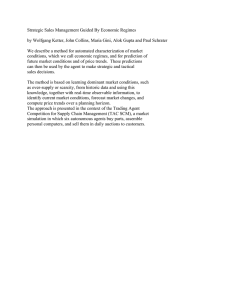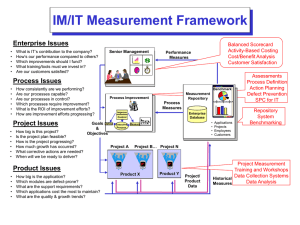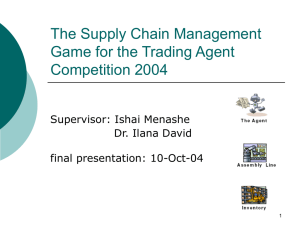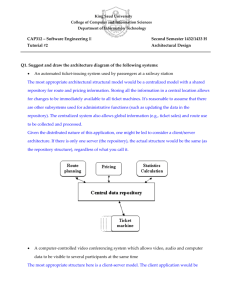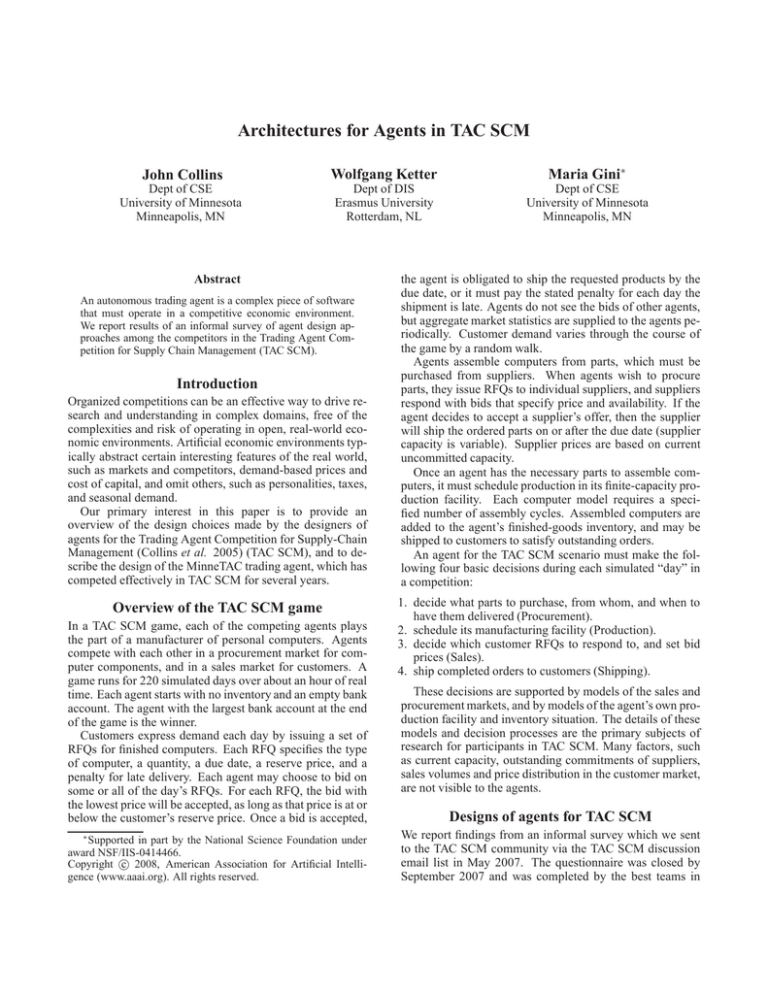
Architectures for Agents in TAC SCM
John Collins
Wolfgang Ketter
Maria Gini∗
Dept of CSE
University of Minnesota
Minneapolis, MN
Dept of DIS
Erasmus University
Rotterdam, NL
Dept of CSE
University of Minnesota
Minneapolis, MN
Abstract
An autonomous trading agent is a complex piece of software
that must operate in a competitive economic environment.
We report results of an informal survey of agent design approaches among the competitors in the Trading Agent Competition for Supply Chain Management (TAC SCM).
Introduction
Organized competitions can be an effective way to drive research and understanding in complex domains, free of the
complexities and risk of operating in open, real-world economic environments. Artificial economic environments typically abstract certain interesting features of the real world,
such as markets and competitors, demand-based prices and
cost of capital, and omit others, such as personalities, taxes,
and seasonal demand.
Our primary interest in this paper is to provide an
overview of the design choices made by the designers of
agents for the Trading Agent Competition for Supply-Chain
Management (Collins et al. 2005) (TAC SCM), and to describe the design of the MinneTAC trading agent, which has
competed effectively in TAC SCM for several years.
Overview of the TAC SCM game
In a TAC SCM game, each of the competing agents plays
the part of a manufacturer of personal computers. Agents
compete with each other in a procurement market for computer components, and in a sales market for customers. A
game runs for 220 simulated days over about an hour of real
time. Each agent starts with no inventory and an empty bank
account. The agent with the largest bank account at the end
of the game is the winner.
Customers express demand each day by issuing a set of
RFQs for finished computers. Each RFQ specifies the type
of computer, a quantity, a due date, a reserve price, and a
penalty for late delivery. Each agent may choose to bid on
some or all of the day’s RFQs. For each RFQ, the bid with
the lowest price will be accepted, as long as that price is at or
below the customer’s reserve price. Once a bid is accepted,
∗
Supported in part by the National Science Foundation under
award NSF/IIS-0414466.
c 2008, American Association for Artificial IntelliCopyright gence (www.aaai.org). All rights reserved.
the agent is obligated to ship the requested products by the
due date, or it must pay the stated penalty for each day the
shipment is late. Agents do not see the bids of other agents,
but aggregate market statistics are supplied to the agents periodically. Customer demand varies through the course of
the game by a random walk.
Agents assemble computers from parts, which must be
purchased from suppliers. When agents wish to procure
parts, they issue RFQs to individual suppliers, and suppliers
respond with bids that specify price and availability. If the
agent decides to accept a supplier’s offer, then the supplier
will ship the ordered parts on or after the due date (supplier
capacity is variable). Supplier prices are based on current
uncommitted capacity.
Once an agent has the necessary parts to assemble computers, it must schedule production in its finite-capacity production facility. Each computer model requires a specified number of assembly cycles. Assembled computers are
added to the agent’s finished-goods inventory, and may be
shipped to customers to satisfy outstanding orders.
An agent for the TAC SCM scenario must make the following four basic decisions during each simulated “day” in
a competition:
1. decide what parts to purchase, from whom, and when to
have them delivered (Procurement).
2. schedule its manufacturing facility (Production).
3. decide which customer RFQs to respond to, and set bid
prices (Sales).
4. ship completed orders to customers (Shipping).
These decisions are supported by models of the sales and
procurement markets, and by models of the agent’s own production facility and inventory situation. The details of these
models and decision processes are the primary subjects of
research for participants in TAC SCM. Many factors, such
as current capacity, outstanding commitments of suppliers,
sales volumes and price distribution in the customer market,
are not visible to the agents.
Designs of agents for TAC SCM
We report findings from an informal survey which we sent
to the TAC SCM community via the TAC SCM discussion
email list in May 2007. The questionnaire was closed by
September 2007 and was completed by the best teams in
Team
Botticelli (B)
University
Brown University (USA)
CMieux (CM)
Carnegie Mellon University (USA)
CrocodileAgent (CA)
University of Zagreb (Croatia)
DeepMaize (DM)
University of Michigan (USA)
Foreseer (F)
MinneTAC (MT)
Cork Constraint Computation
Centre (Ireland)
Aristotle University of
Thessaloniki (Greece)
University of Minnesota (USA)
Southampton (S)
University of Southampton (UK)
TacTex (TT)
University of Texas (USA)
Tiancalli (T)
Benemerita Universidad
Autonoma de Puebla (Mexico)
Mertacor (M)
Team contact and role
Victor Naroditskiy
(team member for 4 years)
Michael Benisch
(team leader 2005/2006)
Vedran Podobnik
(team leader)
Chris Kiekintveld
(team member for 5 years)
David Burke
(main developer)
Andreas Symeonidis
(team member 2006)
John Collins
(team leader and designer)
Minghua He
(designer and programmer)
David Pardoe
(main developer for 5 years)
Daniel Macas Galindo
(team leader)
Table 1: Participating teams in the TAC SCM architecture questionnaire.
previous tournaments. In Table 1 we list the teams who responded to the questionnaire. We categorize the results according to our understanding of the research agendas of the
teams, and by the specific architectural emphases the teams
identified in their agent designs (see Table 2).
Constraint optimization. A supply-chain trading agent
must make its decisions subject to a number of internal and
external constraints. These constraints apply to parts of the
supply-chain, such as procurement (availability of supplies,
reputation), production (limited production capacity), sales
(limited demand, variable pricing), and fulfillment (shipments limited by finished goods inventory). Nearly all the
teams who answered our questionnaire used some form of
constraint optimization, so we list here the ones who highlighted it. The teams who focus on realtime optimization,
Botticelli (Benisch et al. 2004), DeepMaize (Kiekintveld et
al. 2006), Foreseer (Burke et al. 2006), MinneTAC (Ketter et al. 2007) use mainly third party optimization packages, including CPLEX1 , and lp solve2 . An exception is
CMieux (Benisch et al. 2006) which uses an internallydeveloped algorithm to solve a continuous knapsack problem for pricing customer offers.
Machine learning. Many agents use machine learning algorithms to learn from historical market data and have some
ability to learn during operation to adapt to changing situations. CMieux (Benisch et al. 2006), MinneTAC (Ketter
et al. 2007), and TacTex (Pardoe & Stone 2006) identified
the need to support learning and adaptation as primary concerns in the design of their agents. Both CMieux (Benisch et
al. 2006) and TacTex (Pardoe & Stone 2006) use the Weka3
machine learning tool set. MinneTAC is using Matlab4 in
combination with the Netlab5 neural network toolbox to develop and train market models, and to bootstrap the agent
with the resulting models. At runtime, MinneTAC updates
and adjusts those models using feedback and machine learning algorithms embedded in Evaluators.
Management of dynamic supply chains. The TAC SCM
simulation is an abstract model of a highly dynamic direct sales environment. Many teams have a strong research
focus on dynamic supply-chain behavior. These include
CMieux (Benisch et al. 2006), Foreseer (Burke et al. 2006),
Mertacor (Kontogounnis et al. 2006), MinneTAC (Ketter et
al. 2007), and Tiancalli (Galindo, Ayala, & Lopez 2006). As
a consequence teams strive for high flexibility in their agent
design, so that they can easily accommodate changes.
Telecommunication. The CrocodileAgent (Podobnik, Petric, & Jezic 2006) group is part of a larger group that focuses on autonomous agents for management of large-scale
telecommunication networks. They view TAC SCM as a
challenge in building an agent that can operate in a dynamic
environment, but they are also concerned with scalability
and other issues that go far beyond TAC SCM. They base
their design on the JADE6 framework, which is well-proven
for large-scale multi-agent systems.
Architecture. CrocodileAgent (Podobnik, Petric, & Jezic
2006) and Southampton SCM (He et al. 2006) have structured their agent decision processes around the the IKB (In3
http://www.cs.waikato.ac.nz/ml/weka/
http://www.mathworks.com/
5
http://www.ncrg.aston.ac.uk/netlab/
6
http://jade.tilab.com/
4
1
2
http://www.ilog.com/products/cplex/
http://sourceforge.net/projects/lpsolve
Research Agenda
Constraint optimization
Machine learning
Dynamic supply-chain
Telecommunication
Architecture
Empirical game theory
Decision coordination
Dealing with uncertainty
Team
B, CM, DM, F, MT
CM, MT, TT
CM, F, M, MT, T
CA
CA
MT
DM
CM, DM, M, MT, S
B, S
Architectural Emphasis
3rd party packages
External analysis framework, 3rd party packages
Flexibility
Scalability
IKB model for physical distribution
Blackboard architecture with evaluator chain
External analysis framework
Modularity
Modularity
Table 2: Research agendas of teams and their architectural emphasis.
formation, Knowledge, and Behavior) model (Vytelingum
et al. 2005), a three layered agent-based framework. The
first layer contains data gathered from the environment, the
second knowledge extracted from the data, and the third encapsulates the reasoning and decision-making components
that drive agent behavior. CrocodileAgent (Podobnik, Petric, & Jezic 2006) has also adopted the IKB approach. An
advantage of using JADE is that the separation of I, K &
B layers enables physical distribution of layers on multiple computers. Information layer agents parse out information from the TAC SCM server messages, while information and knowledge flows are implemented as JADE agent
communication-based messages.
MinneTAC uses a component based framework. All data
to be shared among components are kept in the Repository,
which acts as a blackboard (Buschmann et al. 1996). MinneTAC is the only team that emphasized a design that attempts to minimize the learning curve for a researcher who
wishes to work on a specific subproblem.
Empirical game theory. The DeepMaize team pursues
empirical game-theoretic analysis as one of their major research cornerstones. They employ an experimental methodology for explicit game-theoretic treatment of multi-agent
systems simulation studies. For example, they have developed a bootstrap method to determine the best configuration of the agent behavior in the presence of adversary
agents (Jordan, Kiekintveld, & Wellman 2007). They also
use game-theoretic analysis to assess the robustness of tournament rankings to strategic interactions. Many of their experiments require hundreds to thousands of simulations with
a variety of competing agents. To support their work they
have developed an extensive framework for setting up and
running experiments, and for gathering and analyzing the
resulting data.
Decision coordination. The supply-chain scenario places
a premium on effective coordination of decisions affecting
multiple markets and internal resources. Decision coordination is an explicit emphasis for the DeepMaize (Kiekintveld
et al. 2006), MinneTAC (Ketter et al. 2007), and Southampton (He et al. 2006) teams. This problem is commonly
viewed as one of enabling independent decision processes to
coordinate their actions while minimizing the need to share
representation and implementation details.
MinneTAC uses a blackboard approach to allow decision
processes to coordinate their actions through a common state
representation. Southampton uses the hierarchical IKB approach, in which the Knowledge layer can be viewed as a
type of blackboard. DeepMaize (Kiekintveld et al. 2006)
treats the combined decisions as a large optimization problem, decomposed into subproblems using a “value-based”
approach. The result is that much of the coordination among
decision processes is effectively managed by assigning values to finished goods, factory capacity, and individual components over an extended time horizon.
Dealing with uncertainty. TAC SCM is designed to
force agents to deal with uncertainty in many dimensions.
Sodomka et al. (Sodomka, Collins, & Gini 2007) provide a
good overview of the sources of uncertainty in the context
of an empirical study of agent performance. The Botticelli
group clearly identifies the problem of dealing with uncertainty as one of their main research goals in (Benisch et al.
2004). SouthamptonSCM (He et al. 2006) employs a bidding strategy that uses fuzzy logic to adapt prices according
to the uncertain market situation.
The design of MinneTAC
In designing MinneTAC we follow a component-oriented
approach. The idea is to provide an infrastructure that
manages data and interactions with the game server, and
cleanly separates behavioral components from each other.
This allows individual researchers to encapsulate agent decision problems within the bounds of individual components
that have minimal dependencies among themselves. Two
pieces of software form the foundation of MinneTAC: the
Apache Excalibur component framework7 and the “agentware” package distributed by the TAC SCM organizers. Excalibur provides the standards and tools to build components
and configure working agents from collections of individual
components, and the agentware package handles interaction
with the game server.
A MinneTAC agent is a set of components layered on
the Excalibur container, as shown in Figure 1. In the standard arrangement, four of these components are responsible for the major decision processes: Sales, Procurement,
Production, and Shipping. All data that must be shared
among components is kept in the Repository, which acts as
7
http://excalibur.apache.org/
a blackboard (Buschmann et al. 1996). The Oracle hosts
a large number of smaller components that maintain market
and inventory models, and do analysis and prediction. The
Communications component handles all interaction with the
game server. By minimizing couplings between the components, this architecture completely separates the major decision processes, thus allowing researchers to work independently. Ideally, each component depends only on Excalibur
and the Repository.
Excalibur Container
Procurement
Communications
Repository
Shipping
Production
Oracle
Sales
Events are generated in response to state transitions, as
visualized in Figure 2. Each simulated day begins in the
start of day state, during which the agent waits for the first
message from the server. In the receiving state, MinneTAC
handles all incoming data messages by storing them in the
Repository. Completion of the daily batch is signified by receipt of a “sim-status” message. The Repository responds
with a transition to the evaluating state and generation of
the data-available event. When a component receives dataavailable it is able to inspect the incoming data for the day’s
transactions and perform whatever analysis is needed to update its models. When this is complete, the Repository
generates the decision event, and transitions to the deciding state. When a component receives the decision event, it
is expected to finalize its decisions and record its outgoing
messages back in the Repository. At the conclusion of decision processing, the accumulated messages are returned to
the game server, and the Repository returns to the start of
day state.
init
start
message/
start of
game
game config
message/
incoming
message/
final config message/
start−of−game event
Figure 1: MinneTAC Architecture. Arrows indicate dependencies.
Repository.
The Repository is the one component that is visible to
other components. Its primary functions are storage and
management of agent state, event distribution, and support
of the Evaluation mechanism discussed below. At the beginning of each day of a game, new incoming messages are
received from the game server and deposited into the Repository. Once the full set of incoming messages has been received, events are generated to notify other components to
perform their analyses and decisions. In response to these
events, the decision components retrieve data and evaluations from the Repository, and record their decisions back
into it. Finally, the resulting decisions are retrieved from the
Repository by the Communications component and returned
to the server.
From an architectural standpoint, the Repository plays
the part of the Blackboard in the Blackboard pattern (Buschmann et al. 1996), and the remainder of the components, other than the Communications component, act as
Knowledge Sources. The Control element of the Blackboard
pattern is replaced by the Event and the Evaluable/Evaluator
mechanisms, which we now describe.
Events. A TAC Agent is basically a “reactive system” in
the sense that it responds to events coming from the game
server. These events are in the form of messages that inform
the agent of changes to the state of the world: Customer
RFQs and orders, supplier offers and shipments, etc. The
game is designed so that each simulated day involves a single exchange of messages; a set of messages sent from the
game server to the agent, and a set returned by the agent
back to the server.
start
of day
Once per day
last
day/
end of
game
incoming
message/
receiving
sim−status message/
data−available event
evaluating
/send messages
/decision event
deciding
Figure 2: States and transitions in the Repository component. Arcs are labeled with event/action pairs.
In processing the data-available and decision events, the
Repository acts as Subject and the other components as Observers in the Observer pattern (Gamma et al. 1995). This
approach has the advantage of eliminating dependency of
the Repository on the specific components. However, an
important limitation of the Observer pattern is that the sequence of notifications is not controlled, although in most
(single-threaded) implementations it is repeatable. But the
order of event processing is important for the MinneTAC decision processes. For example, it greatly simplifies the Sales
decision process to know that the current day’s Shipping decisions have already been made. To allow event sequencing
without introducing new dependencies, two events are generated by the Repository for each day of a game. The dataavailable event is a signal to read the incoming messages
and do basic data analysis. The subsequent decision event
is a signal to make the daily decisions and post the outgoing
messages back in the Repository. The decision event itself
provides an additional level of sequence control by allowing
components to “refuse” the event until one or more other
components (identified by role names) have made their decisions. Components that have refused the event will receive
it again once all other components have had an opportunity
to process it. To ensure that Sales decisions are made after
Shipping decisions, Sales must refuse to accept the decision
event until after it sees “shipping” among the roles that have
already processed it. No additional dependencies are introduced by this mechanism, since the role names are simply
added to the event object itself, and the names come from a
configuration file, not the code.
Oracle. The Oracle component is essentially a metacomponent, since its only purpose is to provide a framework
for a set of small configurable components, instances of the
type ConfiguredObject or its subtypes. These are used to
implement market models and to perform analysis and prediction tasks. The principal subtype is Evaluator, but a few
other types are supported as well. The Oracle itself reads its
configuration data when the agent starts, and uses it to create and configure the specified objects. ConfiguredObject is
an abstract class that has a name and an ability to configure
itself, given an XML clause. The Oracle creates ConfiguredObject instances and keeps track of them by mapping their
names to the created instances.
Another interesting subtype of ConfiguredObject is the
Selector. A Selector is a switch that can be used to select
different models or evaluators in different game situations.
For example, the early part of a game is typically characterized by customer prices that start high and fall rapidly as
agents acquire parts and begin building up inventories. The
behavior of the market during this early period is fairly predictable. Later in the game, prices are less predictable and
more sophisticated models may be useful. A DateSelector
can be used to switch between pricing models at a particular
preset dates, or a more sophisticated Selector can be used to
switch models once the initial price decline bottoms out.
Evaluators. To minimize coupling between components
when a component needs to make a decision, it will inspect
its own internal data and data in the Repository and run some
function. Operations on Repository data can be encapsulated in the form of Evaluations, and made available to other
components.
All the major data elements in the Repository are Evaluable types. Each Evaluable can be associated with some
number of associated Evaluations and with an EvaluationFactory, which maintains a mapping of Evaluation names to
Evaluator instances, and is responsible for producing Evaluations when they are requested. It does this by inspecting the
class of the Evaluable and the name of the requested Evaluation, and invoking the appropriate evaluate method on an
associated Evaluator. Evaluators implement back-chaining
by requesting other Evaluations in the process of producing
their results. Evaluators are hosted by the Oracle component, which is responsible for loading and configuring Evaluators. Evaluators are registered with the Repository when
they are configured, thus making them known to the EvaluationFactory. Figure 3 shows an example of some Evaluable
instances and a set of Evaluations that might be associated
with them. The price evaluation might combine parts cost
information with an estimate of current market conditions.
The profit evaluation would need parts cost information and
price. The sort-by-profit evaluation would need the profit
evaluations on the individual RFQs.
Evaluable
getEvaluation()
CustomerRFQList
CustomerRFQ
model
quantity
dueDate
reservePrice
sort−by−profit
price
profit
order−probability
Figure 3: RFQ evaluation example.
Example of using Evaluators for Sales
To illustrate the power of Evaluators, we show in Figure 4
the evaluation chain that is used to produce sales quotas and
set prices in a relatively simple MinneTAC configuration.
Each of the cells in this diagram is an Evaluator. A version of the Sales component called PriceDrivenSalesManager is conceptually very simple – it places bids on each
customer RFQ for which the randomized-price evaluator returns a non-zero value. The core of this chain is the allocation evaluator, which composes and solves a linear program
each game day that represents a combined product-mix and
resource-allocation problem that maximizes expected profit.
The objective function is
Φ=
h X
X
Φd,g Ad,g
d=0 g∈G
where Φ is the total profit over some time horizon h, G is
the set of goods or products that can be produced by the
agent, Φd,g is the (projected) profit for good g on day d,
and Ad,g is the allocation or “sales quota” for good g on
day d. The constraints are given by evaluators availablefactory-capacity, the current day’s effective-demand, projected future-demand, and by Repository data, such as existing and projected inventories of parts and finished products, and outstanding customer and supplier orders. Predicted profit per unit for each product type is the difference
between Evaluations called median-price and cost-basis for
those products.
The Evaluation generated by the allocation evaluator
gives desired sales quotas for each product over a time horizon. Given a sales quota for a given product and an orderprobability function, the simple-price evaluator computes a
price that is expected to sell the desired quota, assuming that
price is offered on all the demand for that product. In other
words, if the quota is 25 units and the demand is for 100
units, simple-price computes a price that is expected to be
accepted by only 25% of the customers. Since there is some
uncertainty in the predictions of price and order probability, randomized-price adds a slight variability to offer prices.
price−follower
slope−estimate
price−error
median−price
order−probability
cost−basis
allocation
available−supply
simple−price
effective−demand
randomized−price
demand
future−demand
available−factory−capacity
Figure 4: Evaluator chain for sales quota and pricing.
This improves the information content and reduces variability of the returned orders.
Conclusions and Future Work
The survey outcome shows that there are common themes
emerging from the different research groups on how to design a successful agent architecture. in addition to problemspecific approaches. There are also some strong differences
such as how to organize the communication between the different modules and which modules should own the data for
specific tasks.
With the design of MinneTAC we show one way to construct such an agent, using a readily-available component
framework. The framework provides the ability to compose
agent systems from sets of individual components based on
simple configuration files. We also show that two basic
mechanisms, event distribution with the Observer pattern
and our pipe-and-filter style Evaluator-Evaluation scheme,
permit an appropriate level of component interaction without introducing unnecessary coupling among components.
The ability to compose complex evaluator chains out of relatively simple, straightforward elements has greatly simplified the design of the decision components themselves.
References
Benisch, M.; Greenwald, A.; Grypari, I.; Lederman, R.;
Naroditskiy, V.; and Tschantz, M. 2004. Botticelli: A supply chain management agent designed to optimize under
uncertainty. ACM Trans. on Comp. Logic 4(3):29–37.
Benisch, M.; Sardinha, A.; Andrews, J.; and Sadeh, N.
2006. CMieux: adaptive strategies for competitive supply chain trading. In Proc. of 8th Int’l Conf. on Electronic
Commerce, 47–58. ACM Press.
Burke, D.; Brown, K.; Tarim, S.; and Hnich, B. 2006.
Learning Market Prices for a Real-time Supply Chain Management Trading Agent. In AAMAS06: Workshop on Trading Agent Design and Analysis (TADA/AMEC).
Buschmann, F.; Meunier, R.; Rohnert, H.; Sommerlad, P.;
and Stal, M. 1996. Pattern-Oriented Software Architecture: a System of Patterns. Wiley.
Collins, J.; Arunachalam, R.; Sadeh, N.; Ericsson, J.;
Finne, N.; and Janson, S. 2005. The supply chain management game for the 2006 trading agent competition. Technical Report CMU-ISRI-05-132, Carnegie Mellon University, Pittsburgh, PA.
Galindo, D.; Ayala, D.; and Lopez, F. L. Y. 2006. Statistic
analysis for the Tiancalli agents on TAC SCM 2005 and
2006. In Proc. 15th Int’l Conf. on Computing, 161–166.
Gamma, E.; Helm, R.; Johnson, R.; and Vlissides, J. 1995.
Design Patterns: Elements of Reusable Object-Oriented
Software. Addison-Wesley.
He, M.; Rogers, A.; Luo, X.; and Jennings, N. R. 2006.
Designing a successful trading agent for supply chain management. In Proc. of the 5th Int’l Conf. on Autonomous
Agents and Multi-Agent Systems.
Jordan, P.; Kiekintveld, C.; and Wellman, M. 2007. Empirical game-theoretic analysis of the TAC supply chain game.
In Proc. of the 6th Int’l Conf. on Autonomous Agents and
Multi-Agent Systems.
Ketter, W.; Collins, J.; Gini, M.; Gupta, A.; and Schrater,
P. 2007. A predictive empirical model for pricing and resource allocation decisions. In Proc. of 9th Int’l Conf. on
Electronic Commerce, 449–458.
Kiekintveld, C.; Miller, J.; Jordan, P.; and Wellman, M. P.
2006. Controlling a supply chain agent using value-based
decomposition. In Proc. of 7th ACM Conf. on Electronic
Commerce, 208–217.
Kontogounnis, I.; Chatzidimitriou, K. C.; Symeonidis,
A. L.; and Mitkas, P. A. 2006. A Robust Agent Design
for Dynamic SCM environments. In 4th Hellenic Conference on Artificial Intelligence (SETN’06), 127–136.
Pardoe, D., and Stone, P. 2006. Tactex-05: A champion supply chain management agent. In Proc. of the
Twenty-First Nat’l Conf. on Artificial Intelligence, 1389–
1394. Boston, Mass.: AAAI.
Podobnik, V.; Petric, A.; and Jezic, G. 2006. The
CrocodileAgent: Research for Efficient Agent-Based
Cross-Enterprise Processes. Lecture Notes in Computer
Science 4277:752–762.
Sodomka, E.; Collins, J.; and Gini, M. 2007. Efficient statistical methods for evaluating trading agent performance.
In Proc. of the 22nd Nat’l Conf. on Artificial Intelligence,
770–775. Vancouver, BC: AAAI.
Vytelingum, P.; Dash, R.; He, M.; and Jennings, N. 2005.
A Framework for Designing Strategies for Trading Agents.
Proc. IJCAI Workshop on Trading Agent Design and Analysis 7–13.

